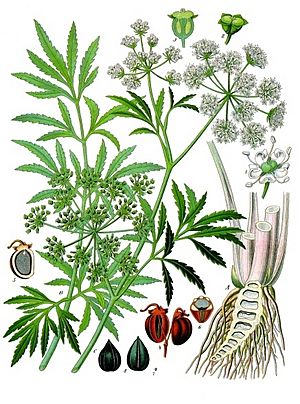Cowbane facts for kids
Quick facts for kids Cowbane |
|
|---|---|
 |
|
| Scientific classification | |
| Genus: |
Cicuta
|
| Species: |
virosa
|
Cicuta virosa, also known as cowbane or northern water hemlock, is a very poisonous plant. It grows naturally in northern and central Europe, northern Asia, and northwestern North America.
This plant is a perennial herbaceous plant. This means it lives for more than two years and has soft, green stems. It can grow quite tall, reaching about 1 to 2 meters (3 to 6 feet).
The stems of the cowbane are smooth and have branches. They are wider at the bottom and have purple stripes. Inside, the stems are hollow, except where the leaves join the stem. If you cut a stem, you'd see one flat side and other rounded sides.
Its leaves grow in an alternating pattern along the stem. They are divided into three main parts and have rough, toothed edges. The flowers are small and white. They grow in clusters that look like umbrellas, which is common for plants in the Apiaceae family.
When the plant is cut, an oily, yellow liquid comes out from the stems and roots. This liquid has a strong smell, a bit like parsnips or carrots. Because its roots grow in white clusters, some people might confuse it with parsnips.
Cowbane likes to grow in wet places. You can find it in damp meadows, along riverbanks, and in marshy areas.
A Look Back: History of Hemlock
For a long time, people have wondered if a plant from the Cicuta genus or the Conium genus was used as a state poison in ancient Greece. This poison was given to people as a way of carrying out the death penalty.
The famous Greek philosopher Socrates drank a cup of some kind of hemlock when he was executed in 399 BC. However, Cicuta virosa mostly grows in northern Europe. It is rare or not found at all in the Mediterranean region. This makes it unlikely that Cicuta virosa was the plant used in Greece. You can learn more about this at Poison hemlock.
Why Cowbane is Dangerous

The cowbane plant contains a strong poison called cicutoxin. This substance harms the central nervous system, which controls your brain and nerves.
If a person eats cowbane, they will quickly feel sick. Symptoms usually start within an hour. They include nausea, vomiting, and abdominal pain. The poisoning can also cause tremors (shaking) and seizures.
Even a small bite of the root can be deadly. The roots have the most cicutoxin. For animals, a very small amount can be fatal. For example, just one gram of water hemlock per kilogram of a sheep's weight can kill it. About 230 grams is enough to kill a horse. Because symptoms appear so fast, it's often too late to treat the poisoning. This is why it's very important to never touch or eat this plant.
Ancient Plant Clues: Fossil Record
Scientists have found fossil parts of Cicuta virosa fruit. These fossils are rare in Pliocene rocks in Europe. However, they are common in Pleistocene interglacial plant remains. These are found in the East European Plain. This shows that cowbane has been around for a very long time.

